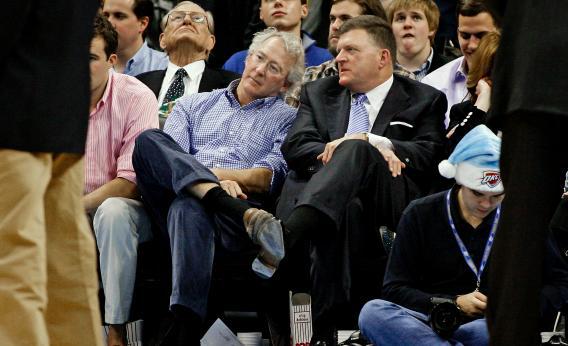Questions about Chesapeake Energy go beyond its chief executive’s dubious dealings. Aubrey McClendon’s personal stakes in oil and gas projects and the extent of related disclosure have put the $12 billion U.S. energy giant on the back foot and tied its board in knots. But investors should also be wary of the company’s monstrous complexity. It has convoluted off-balance sheet liabilities thanks to convoluted partnerships; hedging gains have dwarfed profit since 2006; and cash flow is consistently negative.
Chesapeake, the nation’s second-largest gas producer, has become its own worst enemy. Revelations that McClendon, the company’s flamboyant co-founder, failed to disclose $1.1 billion of personal borrowing to co-invest in wells with the company have raised the specter of serious conflicts of interest and shaken investors. The company originally said its board was “fully” aware of the CEO’s financing transactions, but on Thursday said the directors were only “generally” aware and moved to end the co-investment program - which U.S. regulators are now scrutinizing.
All the while, though, Chesapeake itself is becoming harder and harder to understand. The firm has been scrambling to raise about $10 billion in cash this year to help cope with a hefty debt load and sliding U.S. natural gas prices. Three transactions earlier this month raised $2.6 billion, but added to off-balance sheet debt and made the firm’s structure even more tangled.
Chesapeake has negotiated seven joint ventures which give rival firms part-ownership of oil or gas fields in return for stumping up cash and a portion of drilling costs. No peer has a network of deals on anything close to this scale. Rival Devon Energy, which has a market value more than twice that of Chesapeake, has just one joint venture. And Chesapeake has concluded 10 volumetric production payment deals, under which it will hand over future output in return for cash paid upfront. The company has sold at least $4 billion-worth of its future gas production in this way, according to Argus Research.
Investors wanting to wrap their heads around the firm must also contend with the fact it placed the cash flow from certain wells into a royalty trust - a type of vehicle in which the bulk of profit has to be distributed to its owners - and sold about half its interest for $440 million. The firm is also trying to sell a 20 percent stake through a public offering in its oilfield services firm, Chesapeake Oilfield Services, for $862.5 million.
Visibility is further impeded by the firm’s over-active hedging business. Chesapeake reported realized gains on energy trading of $8.4 billion between 2006 and 2011. That’s more than four times its cumulative $1.8 billion of net income over the same period. “We don’t hedge just to say we’re hedged, we hedge to make money,” Chesapeake declared in a recent investor presentation. No gas rival trades energy on anything close to this scale, and it makes McClendon’s firm look at least as much like a hedge fund as a gas producer.
Yet despite Chesapeake’s opacity and a 20 percent-plus fall in its market value since the end of March alone, investors still seem largely to give the company the benefit of the doubt. Its market capitalization is about $12 billion. That values the company at about 11 times estimated earnings for 2012 - in line with Devon Energy, but below the equivalent ratios for EOG Resources and Encana.
But that isn’t, and shouldn’t be, the whole story. Chesapeake reported net debt of more than $10 billion at the end of its last quarter. That alone makes the firm’s debt load as a proportion of its market value almost twice as large as that of its major peers. But it also has plenty of what can be considered quasi-debt, including $4.3 billion of preferred stock and $1 billion of operating leases.
Analysts think the firm should churn out about $4.3 billion of EBITDA this year. Include the quasi-debt and the market values the entire Chesapeake enterprise at just over six times EBITDA. Rivals like Devon, EOG and Encana are valued at roughly the same level. Yet Chesapeake deserves a discount for its complexity. EOG’s market capitalization is almost three times Chesapeake’s, but the smaller company’s 2011 annual report, as filed with the Securities and Exchange Commission, is more than three times as long. Add in other debt-like obligations, such as $14 billion in off-balance sheet commitments to partners in its various ventures, and investors’ apparent continuing faith in Chesapeake is even more of a head-scratcher.
That’s even before considering the problem of Chesapeake’s cash flow - or lack of it. The firm has reported negative free cash flow every year for the past decade and doesn’t currently expect cash from operations to cover capital expenditures until 2014. Chesapeake can go on selling chunks of its businesses but that tends to mean the best bits get sold first. If the company insists on partial sales, that will add further complexity. And as the web of partnerships becomes denser, the company will get harder to sell as a whole.
With no cash flow and its byzantine structure, Chesapeake is a trust-me story. The CEO’s personal transactions raise questions about the basis for such faith. All the more reason for investors to steer clear unless and until McClendon and his colleagues can explain exactly what’s in the corporate black box they have constructed.
Read more at Reuters Breakingviews.
